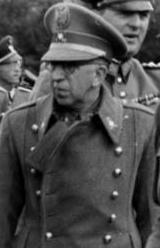Antonio Sagardía Ramos facts for kids
Quick facts for kids
Antonio Sagardía Ramos
|
|
|---|---|

Antonio Sagardía Ramos during a visit to the headquarters of the LSSAH in Berlin-Lichterfelde, September 1940.
|
|
| Birth name | Antonio Sagardía Ramos |
| Nickname(s) | Butcher of Pallars |
| Born | 5 January 1880 Zaragoza, Aragon, Kingdom of Spain |
| Died | 16 January 1962 (aged 82) Madrid, Francoist Spain |
| Allegiance | |
| Service/ |
|
| Rank | |
| Commands held | Military Governor of Cartagena |
| Battles/wars | Spanish Civil War |
| Other work | Inspector General of the Policía Armada |
Antonio Sagardía Ramos (born in Zaragoza, Spain, on January 5, 1880 – died in Madrid, Spain, on January 16, 1962) was a Spanish military officer. He fought for the Nationalist side during the Spanish Civil War. He became known by the nickname "Butcher of Pallars" because of some very harsh events that happened under his command in a place called Pallars Sobirà.
Contents
Who Was Antonio Sagardía Ramos?
Antonio Sagardía Ramos was born in Zaragoza, a city in the Aragon region of Spain. His family had roots in the Basque and Navarre areas. He joined the Spanish Army when he was young. By 1921, he had become a colonel.
When the Second Spanish Republic was declared in 1931, he agreed with the military changes suggested by Manuel Azaña. Because of these changes, he decided to retire from the Army.
His Role in the Spanish Civil War
The Spanish Civil War started in July 1936 after a military uprising. General Emilio Mola, one of the rebel leaders, asked Sagardía Ramos to rejoin the Army. He quickly took command of a group of volunteers from the Falange political party. This group took part in the fighting in the Campaign of Gipuzkoa.
In August and September 1937, Sagardía Ramos was involved in the War in the North. He led a unit known as the "Sagardía Column" during the Battle of Santander. His unit was known for its very strict actions against people and soldiers who were against them.
After the War in the North ended, his "Sagardía Column" was reorganized. It became the 62nd Division of the Navarre Army Corps. With this new division, he took part in the Aragon Offensive. In April 1938, Sagardía's troops were sent to the Battle of the Segre. They faced little resistance there. However, after his column suffered some losses from an attack by the opposing side, he was quoted saying:
I will shoot ten Catalans for every dead man in my guard."
In May 1938, his troops were involved in events in a region called Pallars Sobirà in Catalonia. During these events, many people, including women, older people, and children, lost their lives. In January 1939, Sagardía Ramos also took part in the Catalonia Offensive. A few weeks later, he was part of the "final offensive" of the war. On March 30, his unit entered the city of Alcalá de Henares.
After the War: New Roles
After the Civil War ended, Antonio Sagardía Ramos was given a new important job. He became the Inspector General of the new Policía Armada, which was a type of armed police force. In this role, he was part of a group that visited Nazi Germany in September 1940.
The next month, in October 1940, he was one of the important people who met Heinrich Himmler in San Sebastián. Himmler was a very powerful leader from Nazi Germany, known as the Reichsführer-SS.
Later, Sagardía Ramos also served as the military governor of Cartagena, an important port city in Spain.
See also
 In Spanish: Antonio Sagardía Ramos para niños
In Spanish: Antonio Sagardía Ramos para niños

